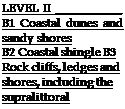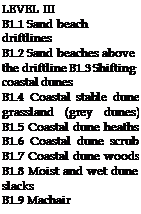The EUNIS habitat classification is a common reporting language on habitat types at European level, sponsored by the EEA. It originated from a combination of several habitat classifications – marine, terrestrial and freshwater. The terrestrial and freshwater classification builds upon previous initiatives, notably the CORINE biotopes classification (Devillers & Devillers-Terschuren 1991), the Palaearctic habitats classification (Devillers & Devillers-Terschuren 1996), of the EU Habitats Directive 92/43/EEC, the CORINE Land
Cover nomenclature (Bossard et al. 2000), and the Nordic habitat classification (Nordic Council of Ministers 1994). The marine part of the classification was originally based on the BioMar classification (Connor et al 1997), covering the North-East Atlantic. The EUNIS habitat classification introduced agreed criteria for the identification of each habitat unit, while providing a correspondence with these earlier classification systems.
The habitat classification forms an integral part of the EUNIS, developed and managed by the European Topic Centre for Nature Protection and Biodiversity (ETC/NPB in Paris) for the EEA and the European Environmental Information Observation Network (EIONET). The EUNIS web application (http://eunis. eea. europa. eu) (EEA 2012a) provides access to publicly available data in a consolidated database.
The information includes:
• Data on Species, Habitats and Sites compiled in the framework of NATURA2000 (EU Habitats and Birds Directives),
• Data collected from frameworks such as EIONET, data sources or material published by ETC/NPB (formerly the European Topic Centre for Nature Conservation).
• Information on Species, Habitats and Sites taken into account in relevant international conventions or from International Red Lists.
• Specific data collected in the framework of the EEA’s reporting activities, which also constitute a core set of data to be updated periodically.
The resulting system of classification is still somewhat transitional. Down to level 3 (terrestrial and freshwater) and level 4 (marine), EUNIS habitats are now based on physiognomic and physical attributes, together with some floristic criteria. There are 10 main habitat categories in this scheme. Coastal habitats and main categories as an example were presented in this chapter (table 2). Detailed information can be found in revised EUNIS habitat classification report of Davies et al. (2004).

 LEVEL I________________________
LEVEL I________________________
A. Marine habitats
B. Coastal habitats
C. Inland surface waters
D. Mires, bogs and fens
E. Grasslands and lands dominated by forbs, mosses or lichens
F. Heathland, scrub and tundra
G. Woodland, forest and other wooded land
H. Inland unvegetated and sparsely vegetated habitats
I. Regularly or recently cultivated agricultural, horticultural and domestic habitats
J. Constructed, industrial and other artificial habitats
Table 2. Main EUNIS habitat classes and sample levels of coastal habitats.
|
Furniture Design Ideas © 2021
Frontier Theme
|
